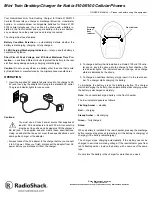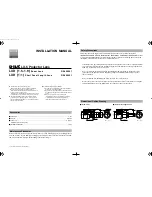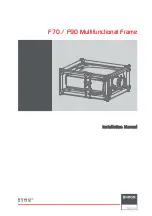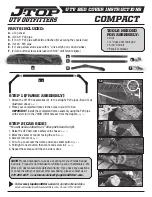
5. Reset the sensor by communication command from the panel.
TESTING
Detectors must be tested after installation and following periodic main-
tenance. However, before testing, notify the proper authorities that the
smoke detector system is undergoing maintenance and the system will
be temporarily out of service. Disable the zone or system undergoing
maintenance to prevent unwanted alarms.
Test the sensors as follows:
A. Test Magnet (Model M02-04 – optional)
1. Test the sensor by positioning the optional test magnet against
the sensor plastic in the magnet test area, as shown in Figure 3.
2. Both
LEDs
should
latch
on
within
30
seconds,
indicating an alarm and annunciating the panel.
B. Smoke Entry: Aerosol Generator (Gemini 501)
The GEMINI model 501 aerosol generator can be used for
smoke entry testing. Set the generator to represent 4%/ft to 5%/
ft obscuration as described in the GEMINI 501 manual. Using the
bowl shaped applicator, apply aerosol until the panel alarms.
CLEANING
Before cleaning, notify the proper authorities that the system is under-
going maintenance and will be temporarily out of service. Disable the
system to prevent unwanted alarms.
1. Remove the sensor to be cleaned from the system.
2. Remove the sensor cover, see Figure 4. Use a small standard screw-
driver to release each of the four cover removal tabs that hold the cover
in place.
3. Vacuum the outside of the screen carefully without removing it.
4. Remove the sensor screen. Pull the screen straight away from the
sensing chamber until it snaps out of place. Replacement screens are
available.
N500-57-00
2
I56-1249-04R
©2001 Notifier
Figure 3. Test Magnet Positioning
Figure 4. Cleaning
A78-2463-13
SENSOR
COVER
SENSING
CHAMBER
SENSOR
SCREEN
COVER REMOVAL
TABS
PC BOARD
CONTACT
SENSOR
CONTACTS
LED 2
LED 1
PAINTED
SURFACE
TEST
MAGNET
MAGNET
TEST MARKER
A78-2424-10
5. Use a vacuum cleaner or clean, compressed air to remove dust and
debris from the sensing chamber.
6. Reinstall or replace the sensing chamber screen by sliding the edge
without the tabs over the sensing chamber. Make sure that one of the
screen contacts touches the circuit board contact.
7. Reinstall the sensor cover. Use the LEDs to align the cover with the
sensor. Snap the cover into place.
8. When all sensors have been cleaned, restore power to the system
and test the sensor(s) as described in the TESTING section of this
manual.
FCC Statement
This device complies with part 15 of the FCC Rules. Operation is subject to the following two conditions: (1) This device may not cause harmful interference, and (2) this
device must accept any interference received, including interference that may cause undesired operation.
Note: This equipment has been tested and found to comply with the limits for a Class B digital device, pursuant to Part 15 of the FCC Rules. These limits are designed to
provide reasonable protection against harmful interference in a residential installation. This equipment generates, uses and can radiate radio frequency energy and, if not
installed and used in accordance with the instructions, may cause harmful interference to radio communications. However, there is no guarantee that interference will not
occur in a particular installation. If this equipment does cause harmful interference to radio or television reception, which can be determined by turning the equipment off and
on, the user is encouraged to try to correct the interference by one or more of the following measures:
– Reorient or relocate the receiving antenna.
– Increase the separation between the equipment and receiver.
– Connect the equipment into an outlet on a circuit different from that to which the receiver is connected.
– Consult the dealer or an experienced radio/TV technician for help.
Please refer to insert for the Limitations of Fire Alarm Systems
www.PDF-Zoo.com




















